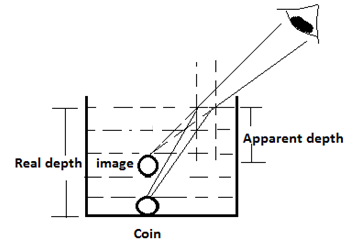
A coin is placed at the bottom of a tin can. Move your eyes until the coin is just out of sight (see diagram). Keep your eyes in this position while someone pours water gradually into the tin can. What would you observe? Explain your observation.


Answer
560.1k+ views
Hint: When we look at the coin, right above the top of the tin can, light rays from the coin will reach us directly. But when we slowly move away from the can, the coin starts disappearing. Here, water is denser medium and air is a rarer medium. When light rays travel from denser to rarer medium it bends its path. And the image of the coin will be visible.
Complete answer:
The coin was visible, when it was initially placed in the tin can. When we move away from the can, the coin starts disappearing from our sight. Because, the light rays from the coin will not reach our eyes. When water is poured, light rays from the coin travels in a straight line until it reaches the surface of water, then it bends. When produced backwards these light rays appear to come from a different position. Since this position is at a higher level than the original position of the coin, the coin appears raised and becomes visible. The raised height of the coin is called apparent depth. This phenomenon is known as refraction. It is described as, when light rays travel from a denser medium to rarer medium it bends its path away from the normal line.
Note:
The amount of bending of light rays can be measured using a refractive index. The refractive index is defined as the ratio of the sine of the angle of incidence to the sin of the angle of refraction. If two mediums have the same refractive indices then light rays will not bend while travelling from one medium to the other.
Complete answer:
The coin was visible, when it was initially placed in the tin can. When we move away from the can, the coin starts disappearing from our sight. Because, the light rays from the coin will not reach our eyes. When water is poured, light rays from the coin travels in a straight line until it reaches the surface of water, then it bends. When produced backwards these light rays appear to come from a different position. Since this position is at a higher level than the original position of the coin, the coin appears raised and becomes visible. The raised height of the coin is called apparent depth. This phenomenon is known as refraction. It is described as, when light rays travel from a denser medium to rarer medium it bends its path away from the normal line.
Note:
The amount of bending of light rays can be measured using a refractive index. The refractive index is defined as the ratio of the sine of the angle of incidence to the sin of the angle of refraction. If two mediums have the same refractive indices then light rays will not bend while travelling from one medium to the other.
Recently Updated Pages
Master Class 11 Business Studies: Engaging Questions & Answers for Success

Master Class 11 Computer Science: Engaging Questions & Answers for Success

Master Class 11 Maths: Engaging Questions & Answers for Success

Master Class 11 Chemistry: Engaging Questions & Answers for Success

Master Class 11 Economics: Engaging Questions & Answers for Success

Master Class 11 Accountancy: Engaging Questions & Answers for Success

Trending doubts
What is meant by exothermic and endothermic reactions class 11 chemistry CBSE

10 examples of friction in our daily life

One Metric ton is equal to kg A 10000 B 1000 C 100 class 11 physics CBSE

1 Quintal is equal to a 110 kg b 10 kg c 100kg d 1000 class 11 physics CBSE

Difference Between Prokaryotic Cells and Eukaryotic Cells

What are Quantum numbers Explain the quantum number class 11 chemistry CBSE




